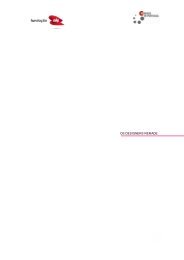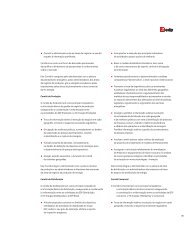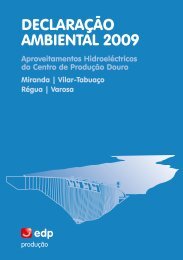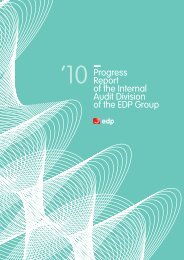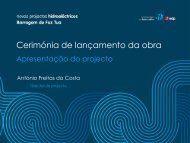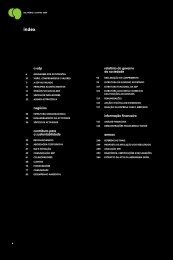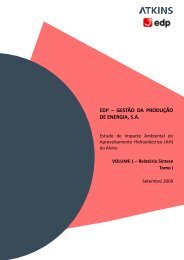Annual Report - EDP
Annual Report - EDP
Annual Report - EDP
- No tags were found...
Create successful ePaper yourself
Turn your PDF publications into a flip-book with our unique Google optimized e-Paper software.
notes to the consolidated <strong>EDP</strong> and - Energias company de Portugal, financial S.A. statementsfor the Notes years to the ended Consolidated 31 december and Company 2012 Financial and Statements 2011for the years ended 31 December 2012 and 2011The Group carries out impairment tests whenever events or circumstances may indicate that the book value of an asset exceeds its recoverable amount, being anyimpairment recognised in the income statement.The recoverable amount is the higher of net selling price and value in use, the latter being calculated by the present value of the estimated future cash flows obtainedfrom continued use of the asset and its sale at the end of its useful life.Land is not depreciated. Depreciation of tangible assets is calculated on a straight-line basis over their estimated useful lives, as follows:Number ofyearsBuildings and other constructions 8 to 50Plant and machinery:Hydroelectric generation 32 to 75Thermoelectric generation 25 to 40Renewable generation 25Electricity distribution 10 to 40Other plant and machinery 5 to 10Transport equipment 4 to 25Office equipment and tools 4 to 10Other property, plant and equipment 10 to 25According to IFRS, the estimate of the useful life of assets should be reviewed whenever a change occurs in the expected economic benefits flowing from the assets aswell as when the technical use planned for the assets differs from previous estimates. Changes ocurring in the depreciation charge of the year are accounted forprospectively.Borrowing costs and other directly attributable costsBorrowing costs that are directly attributable to the acquisition or construction of assets are capitalised as part of the cost of the assets. A qualifying asset is an assetthat needs a substantial period of time to be ready for its intended use or sale. The amount of interest costs eligible for capitalisation is determined by applying acapitalisation rate to the expenditures on those assets. The capitalisation rate corresponds to the weighted average of the borrowing costs applicable to theoutstanding borrowings during the period. The capitalisation of borrowing costs begins when expenditure for the assets is being incurred, borrowing costs have beenincurred and activities necessary to prepare all or part of the assets for their intended use or sale are in progress. Capitalisation ceases when substantially all theactivities necessary to prepare the qualifying assets for their intended use or sale are completed. Other expenses directly attributable to the acquisition andconstruction of the assets, such as cost of consumed materials and personnel costs, are also capitalised as part of the cost of the assets.Government grantsGovernment grants are initially booked as deferred revenue, under non current liabilities only when there is reasonable certainty that the grant will be received andthat the Group will fulfil the grant term conditions. Grants that compensate the Group for expenses incurred are booked in the income statement on a linear basis, onthe same period in which the expenses are incurred. Grants that compensate the Group for the acquisition of assets are recognised in the income statement over therelated assets useful life.Transfers of assets from customersThe International Financial <strong>Report</strong>ing Interpretations Committee (IFRIC) issued in November 2008, the interpretation IFRIC 18 - Transfers of Assets from Customers. Thisinterpretation was approved by the European Commission on 27 November 2009, being applicable for periods beginning after 31 October 2009. For <strong>EDP</strong> Group, thefirst period after the approval of this interpretation is the year 2010.IFRIC 18 is applicable for agreements in which an entity receives from a customer an item of Property, plant, and equipment that the entity must then use either toconnect the customer to a network or to provide the customer with ongoing access to a supply of energy. This interpretation clarifies: the conditions in which an asset is under this interpretation; recognition of the asset and its initial measurement; identification of the services identified (one or more services in exchange for assets transferred); income recognition; and accounting for the transfer of money from customers.The Group adopted this interpretation for the allowances received from customers, recognising the assets received by its estimated construction cost againstoperating income. The assets are depreciated based on its useful life.i) Intangible assetsThe Group's intangible assets are booked at acquisition cost less accumulated amortisation and impairment losses.The Group performs impairment reviews whenever events or circumstances may indicate that the book value of the asset exceeds its recoverable amount, anyimpairment being recognised in the income statement. The recoverable amount is the higher of net selling price and value in use, the latter being calculated by thepresent value of the estimated future cash flows obtained from continued use of the asset and its sale at the end of its useful life.Acquisition and development of softwareThe costs of purchasing software and the costs incurred by the Group to implement it are capitalised and amortised on a straight-line basis over the expected usefullife of the software.182A World Full Of Energy







